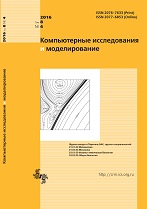|
MATHEMATICAL MODELING AND NUMERICAL SIMULATION
Comparative analysis of finite difference method and finite volume method for unsteady natural convection and thermal radiation in a cubical cavity filled with a diathermic medium
N. S. Bondareva, N. S. Gibanov, S. G. Martyushev, I. V. Miroshnichenko, M. A. Sheremet
Laboratory on Convective Heat and Mass Transfer,
National Research Tomsk State University,
Lenin ave. 36, Tomsk, 634050, Russia
Abstract:
Comparative analysis of two numerical methods for simulation of unsteady natural convection and thermal surface radiation within a differentially heated cubical cavity has been carried out. The considered domain of interest had two isothermal opposite vertical faces, while other walls are adiabatic. The walls surfaces were diffuse and gray, namely, their directional spectral emissivity and absorptance do not depend on direction or wave-length but can depend on surface temperature. For the reflected radiation we had two approaches such as: 1) the reflected radiation is diffuse, namely, an intensity of the reflected radiation in any point of the surface is uniform for all directions; 2) the reflected radiation is uniform for each surface of the considered enclosure. Mathematical models formulated both in primitive variables “velocity – pressure” and in transformed variables “vector potential functions – vorticity vector” have been performed numerically using finite volume method and finite difference methods, respectively. It should be noted that radiative heat transfer has been analyzed using the net-radiation method in Poljak approach. Using primitive variables and finite volume method for the considered boundary-value problem we applied power-law for an approximation of convective terms and central differences for an approximation of diffusive terms. The difference motion and energy equations have been solved using iterative method of alternating directions. Definition of the pressure field associated with velocity field has been performed using SIMPLE procedure. Using transformed variables and finite difference method for the considered boundary-value problem we applied monotonic Samarsky scheme for convective terms and central differences for diffusive terms. Parabolic equations have been solved using locally one-dimensional Samarsky scheme. Discretization of elliptic equations for vector potential functions has been conducted using symmetric approximation of the second-order derivatives. Obtained difference equation has been solved by successive over-relaxation method. Optimal value of the relaxation parameter has been found on the basis of computational experiments. As a result we have found the similar distributions of velocity and temperature in the case of these two approaches for different values of Rayleigh number, that illustrates an operability of the used techniques. The efficiency of transformed variables with finite difference method for unsteady problems has been shown.
Keywords:
natural convection, thermal surface radiation, diathermic medium, primitive variables, finite volume method, transformed variables, finite difference method.
Received: 31.03.2017
Revised: 09.06.2017
Accepted: 20.06.2017
Citation:
N. S. Bondareva, N. S. Gibanov, S. G. Martyushev, I. V. Miroshnichenko, M. A. Sheremet, “Comparative analysis of finite difference method and finite volume method for unsteady natural convection and thermal radiation in a cubical cavity filled with a diathermic medium”, Computer Research and Modeling, 9:4 (2017), 567–578
Linking options:
https://www.mathnet.ru/eng/crm83 https://www.mathnet.ru/eng/crm/v9/i4/p567
|

| Statistics & downloads: |
| Abstract page: | 371 | | Full-text PDF : | 208 | | References: | 41 |
|




 Contact us:
Contact us: Terms of Use
Terms of Use
 Registration to the website
Registration to the website Logotypes
Logotypes









 Citation in format
Citation in format 